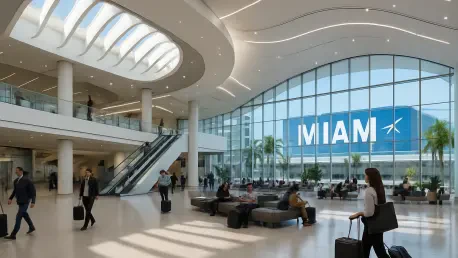I’m thrilled to sit down with Katarina Railko, a seasoned expert in hospitality, travel, and tourism, whose extensive experience also spans entertainment and events, particularly expos and conferences. With her deep understanding of industry dynamics, Katarina offers invaluable insights into the recent developments at Miami International Airport (MIA), which has just secured a significant $94 million in FAA grants for its ambitious modernization efforts. In our conversation, we explore the implications of this funding, the broader vision for MIA’s transformation, its impact on the local economy, and how these upgrades position the airport as a global gateway for the future.
Can you give us a broad perspective on what securing $94 million in FAA grants means for Miami International Airport?
This funding is a game-changer for MIA. It’s a substantial boost to their $9 billion modernization plan, which aims to transform the airport into a cutting-edge, future-ready hub. The $94 million, the highest amount awarded to any U.S. airport in 2025 so far, signals strong federal support for MIA’s vision. It’s not just about the dollars—it’s about accelerating critical projects that will enhance capacity, improve passenger experience, and ensure long-term sustainability. This kind of investment underscores MIA’s importance as a key player in national and international aviation.
How does this funding impact the local economy and community in Miami-Dade County?
The economic ripple effects are massive. This investment is poised to create numerous good-paying jobs, from construction to long-term airport operations roles. Beyond jobs, it strengthens MIA as an economic engine for the region, driving tourism and freight—two pillars of Florida’s economy. For the community, it means having an airport that can handle growth while being more resilient to challenges like storms. It’s about pride, too—having a world-class gateway that reflects the vibrancy of Miami-Dade County and welcomes travelers with top-notch facilities.
Could you break down how the specific allocations of $70 million from the Airport Improvement Program and $24 million from the Airport Infrastructure Grant will be utilized?
Certainly. The $70 million from the Airport Improvement Program is likely to target core infrastructure needs, such as airfield upgrades to handle more aircraft and cargo efficiently. The $24 million from the Airport Infrastructure Grant will probably focus on complementary projects, like terminal enhancements or mobility solutions. While exact details on project prioritization aren’t fully public yet, these funds will fast-track high-priority initiatives within the broader modernization plan, ensuring MIA addresses immediate capacity constraints while building for the future.
What are the overarching goals of MIA’s Future-Ready Modernization in Action program?
This multi-year initiative is incredibly ambitious, aiming to overhaul nearly every aspect of the airport over the next decade. The main goals are to boost capacity and resilience while enhancing the traveler experience. This includes upgrading the airfield and roadways for smoother operations, expanding terminals with new concourses for better passenger flow, investing in sustainability through energy-efficient systems and storm-resistant designs, and improving parking and transportation options to make access easier. It’s about preparing MIA for the next generation of aviation demands.
How do these modernization efforts help MIA maintain its competitive edge as a global gateway?
MIA is already a leader in international freight and passenger traffic, but staying competitive means keeping up with rising demand and global standards. These upgrades will expand capacity to manage more flights and cargo, which is critical as traffic continues to break records. They also ensure the airport can adapt to future aviation trends, like larger aircraft or increased regional connectivity. By investing in modern, efficient infrastructure, MIA solidifies its role as a vital link between the U.S., Latin America, the Caribbean, and beyond.
Can you elaborate on MIA’s role in Florida’s tourism and logistics ecosystem?
MIA is the heartbeat of Florida’s international connectivity. It handles about 60% of the state’s international arrivals, making it a cornerstone for tourism—a huge driver of the economy. On the logistics side, it’s the busiest U.S. airport for international freight, supporting commerce with billions in business revenue. Its strategic location makes it a gateway for goods and people, linking Florida to global markets. The modernization will only amplify this impact, ensuring smoother operations for airlines, businesses, and travelers alike.
What is your forecast for the future of MIA with these transformative projects underway?
I’m very optimistic about MIA’s trajectory. With this funding and the broader modernization plan, I see it becoming a benchmark for what a 21st-century airport should be—efficient, sustainable, and passenger-focused. In the next decade, I expect MIA to not only handle significantly higher volumes of passengers and cargo but also to set new standards in resilience and innovation. This could inspire similar transformations at other U.S. airports, positioning MIA as a leader in shaping the future of global aviation.









